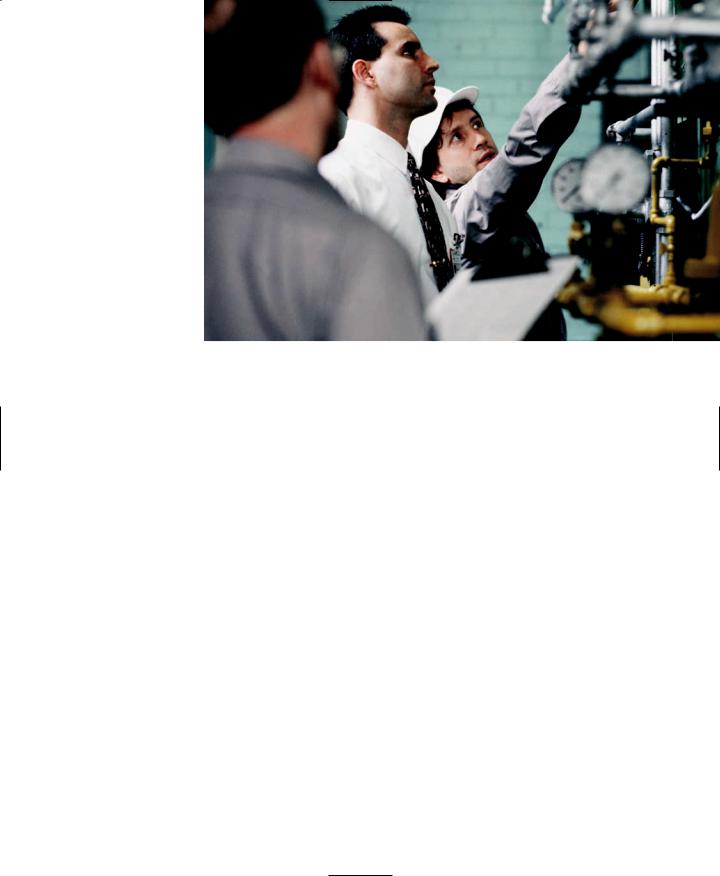
- •CONTENTS
- •PREFACE
- •Content—Benefits for Students
- •Content—Benefits for Instructors
- •Features of the Book for Students and Instructors
- •Supplementary Materials
- •Acknowledgments
- •What Is Hospitality Management?
- •The Manager’s Role in the Hospitality Industry
- •Why Study in a Hospitality Management Program?
- •Planning a Career
- •Employment as an Important Part of Your Education
- •Getting a Job
- •Employment at Graduation
- •The Outlook for Hospitality
- •Summary
- •Managing Change
- •Demand
- •Supply
- •Workforce Diversity
- •The Impact of Labor Scarcity
- •Summary
- •The Varied Field of Food Service
- •The Restaurant Business
- •The Dining Market and the Eating Market
- •Contemporary Popular-Priced Restaurants
- •Restaurants as Part of a Larger Business
- •Summary
- •Restaurant Operations
- •Making a Profit in Food Service Operations
- •Life in the Restaurant Business
- •Summary
- •Chain Restaurant Systems
- •Independent Restaurants
- •Franchised Restaurants
- •Summary
- •Competitive Conditions in Food Service
- •The Marketing Mix
- •Competition with Other Industries
- •Summary
- •Self-Operated Facilities
- •Managed-Services Companies
- •Business and Industry Food Service
- •College and University Food Service
- •Health Care Food Service
- •School and Community Food Service
- •Other Segments
- •Vending
- •Summary
- •Consumer Concerns
- •Food Service and the Environment
- •Technology
- •Summary
- •The Evolution of Lodging
- •Classifications of Hotel Properties
- •Types of Travelers
- •Anticipating Guest Needs in Providing Hospitality Service
- •Service, Service, Service
- •Summary
- •Major Functional Departments
- •The Rooms Side of the House
- •Hotel Food and Beverage Operations
- •Staff and Support Departments
- •Income and Expense Patterns and Control
- •Entry Ports and Careers
- •Summary
- •The Economics of the Hotel Business
- •Dimensions of the Hotel Investment Decision
- •Summary
- •The Conditions of Competition
- •The Marketing Mix in Lodging
- •Product in a Segmented Market
- •Price and Pricing Tactics
- •Place—and Places
- •Promotion: Marketing Communication
- •Summary
- •The Importance of Tourism
- •Travel Trends
- •The Economic Significance of Tourism
- •The United States as an International Tourist Attraction
- •Businesses Serving the Traveler
- •Noneconomic Effects of Tourism
- •Summary
- •Motives and Destinations
- •Mass-Market Tourism
- •Planned Play Environments
- •Casinos and Gaming
- •Urban Entertainment Centers
- •Temporary Attractions: Fairs and Festivals
- •Natural Environments
- •On a Lighter Note. . .
- •Summary
- •Management and Supervision
- •The Economizing Society
- •The Managerial Revolution
- •Management: A Dynamic Force in a Changing Industry
- •What Is Management?
- •Summary
- •Why Study Planning?
- •Planning in Organizations
- •Goal Setting
- •Planning in Operations
- •The Individual Worker as Planner
- •Long-Range Planning Tools
- •Summary
- •Authority: The Cement of Organizations
- •Departmentalization
- •Line and Staff
- •Issues in Organizing
- •Summary
- •Issues in Human-Resources Management
- •Fitting People to Jobs
- •Recruiting
- •Selection and Employment
- •Training
- •Retaining Employees
- •Staff Planning
- •Summary
- •The Importance of Control
- •Control and the “Cybernetic Loop”
- •Tools for Control
- •Summary
- •Leadership as Viewed by Social Scientists
- •Why People Follow
- •Leadership Theories
- •Communication
- •The Elements of Leading and Directing
- •Developing Your Own Leadership Style
- •Summary
- •A Study of Service
- •Rendering Personal Service
- •Managing the Service Transaction
- •How Companies Organize for Service
- •Summary
- •INDEX

502 |
Chapter 15 Management: A New Way of Thinking |
Management and Supervision
Students considering a career in hospitality management naturally want to understand the hospitality profession in general and the various kinds of opportunities it offers. It is equally important for them to understand the work that supervisors and managers do. We have devoted a major portion of this text to discussions of this
work. Let’s turn our attention first to supervision.
The word supervision is derived from two Latin words that, taken together, mean “to oversee.” As such, supervision involves principally the direction and leadership functions of management. (These two functions will receive special attention in Chapter 20.) Supervisors are also involved in the other functions of management that we will soon be discussing. They must plan, and they must understand the plans made by senior management that they will follow in their operations. They must understand and come to function effectively within a complex organization. One particularly important responsibility, staffing (discussed in Chapter 18), is at the heart of a hospitality supervisor’s work. Additionally, the control function cannot be carried out without supervisors becoming sources of information and of the corrective action indicated by control systems.
There are some slight differences between supervision and management. The supervisor’s work occurs at the operating level; that is, he or she works directly with the employees as they do their work. Management, on the other hand, is concerned with the totality of the organization’s problems. Managers engaged in long-range planning may well discover a need, for example, to redesign the organization structure or the control system. Very often, especially in large organizations, managers direct the work of supervisors, who, in turn, direct the employees’ actual tasks.
From a student’s perspective, it is important to remember that in the hospitality industry, nearly all managers begin as supervisors, and able supervisors usually advance through the ranks to senior positions. Even there, however, a manager’s work may have a supervisory component—the actual direction of employees in productive tasks. As a practical matter, then, management and supervision are so closely intertwined as to make distinguishing between them a theoretical exercise with little practical value for us. To be sure, we will often refer to supervision and management, but by itself, the term management usually includes supervision and is the preferred term when speaking in generalizations. The next six chapters will explore the work of managers and supervisors. In this chapter, we will define management and address its development as a body of knowledge.
Although managing—both the designing and organizing of work and the overseeing of it—is as old as civilization, management as an organized body of thought is

The Economizing Society |
503 |
only about 100 years old. Indeed, until recent times, the way that society was organized made it unlikely (useless, really) to consider management as a field of study and thought.
In this and the following chapters, we will also use the term business. In fact, modern management has been mainly a development of the private sector, or the business community. However, students whose interests lie in nonbusiness areas such as administrative dietetics or community food service programs should not feel at all left out, because nonprofit and government-funded food service programs now widely use these same techniques. In fact, minor adjustments make modern business management relevant to almost any managerial task.
The Economizing Society
The economist Robert Heilbroner identified three means of organizing a society and dealing with its economic problems: tradition, command, and the market system.1 The two means with the longest history are tradition and command, whereas the market system, by contrast, emerged from medieval Europe along with our mod-
ern age.
Tradition embodies the wisdom of experience, gained through trial and error, in a set of social customs regarded as nearly unchangeable. Primitive societies are traditional societies. Primitives regard the idea of change with fear, and so their whole society is based on the absence of change. For this reason, tradition offers only meager guidance in the modern world.
Command—imposed authority—is a solution to society’s problems often associated with traditional society. Command was the mode of social control of such ancient empires as the ones the Egyptians and Romans built, and it is the means by which modern dictatorships rule.
The market system (as defined by economists) emphasizes the free choice of individuals. In theory, consumer decisions govern the allocation of resources, and competition sets the prices in the marketplace. In practice, critics point out, there are many imperfections in the market system, but we must recognize it as a system that offers consumers—and workers—more choice than does any other system the world has ever seen.
One central idea of the market economy completely foreign to most other cultures (including that of medieval Europe, out of which our society developed) is the idea of individual gain or profit seeking not just as a legitimate activity but also as a cornerstone of our civilization. Traditional societies are based principally on community interests, but the market system encourages, indeed exalts, individual interest.

504 |
Chapter 15 Management: A New Way of Thinking |
Management focuses on the problems of large organizations, though it is used in all sizes of organizations. In premodern times, such management thought served the church and the military. As royal power and ancient tradition were displaced by an economizing society and the market system, the creative energies of businesspeople began to occupy a more central place in Western civilization, particularly in the United States. In the nineteenth century, large business organizations came into being, and with them came a need to develop theories to deal with the complex problems associated with those organizations. The field of management was born.
Management is struggling to deal with a greater consciousness of community values regarding matters such as the environment as well as individual gain as joint determinants of economic action. Because management’s values derive from the changing values of the society in which it works, we can expect that a change in society’s consensus on the importance of individual choice in the marketplace will have a major impact on management now and in the future. Management, still barely 100 years old, has already passed through a number of changes. Given the changing society out of which management arises, there is bound to be further development in the field.
Management is a very modern institution; indeed, it is a new way of viewing the problems of work in an expanding and increasingly wealthy society. This new way of viewing problems has become one of the strongest forces in the last 100 years of our civilization’s development. Because this development has been so rapid, our view of management problems has changed dramatically during that period. Management continues to change along with the dynamic society in which it operates, and so those entering a career in management must prepare themselves for constant change. It is useful, therefore, for us to examine briefly the contributions of the early management theorists to see the power of their ideas and how this young field of ours grew.
The Managerial Revolution
The problems that management deals with weren’t really problems at all in the traditional and command economies. People worked at what their parents had worked at; they did what they were told to do. The problem of motivation was largely solved by the fact that the worker’s alternative to following orders was starvation. Even in early modern times, when democracy was still growing in the political realm and had little to do with our economic way of life, people worked for low wages. More
applicants were always standing at the door if any employee wanted to leave.
The two thinkers generally credited with laying the foundation of modern management are Frederick Taylor and Henri Fayol. As we will learn, they were concerned with quite different problems. Taylor formulated industrial engineering principles and

Managers must understand all aspects of the operation. (Courtesy of Sodexho.)
a wholly new way of organizing tasks. Fayol voiced the first ideas underlying what has come to be called organizational theory.
TAYLOR: THE WORK PROCESS FOCUS
Frederick Taylor founded the scientific management movement. He believed that “the most prominent single element in modern scientific management is the task idea.” Taylor argued that instead of “herding men in large groups” and relying on brute strength of numbers, a careful study of the work to be done and the worker would result in greatly increased productivity, that is, in more units of output per unit of labor input. Although the Industrial Revolution achieved a revolution in productivity through the use of machines, Taylor offered a further revolution through improved work planning and a work process focus. Here is Taylor’s own summation:
Scientific management consists of a certain philosophy which results in a combination of four underlying principles of management: first, the development of a true science; second, the scientific selection of the workman; third, his scientific education and development; and fourth, intimate, friendly cooperation between management and men.2
Let us briefly consider each of Taylor’s points. His “true science,” based on time- and-motion studies, eventually became the new field of industrial engineering. His
505

506Chapter 15 Management: A New Way of Thinking
idea was to make management’s study and planning of the work, rather than numbers and strength (or traditional skill), the controlling factor in work. It was a revolutionary proposal. His method of studying and planning the work meant analyzing each task and developing the “one best way” to do it. Moreover, his approach replaced the artisan shop, based on traditional skills, with the controlled shop, a productive process in which management planning rather than worker skill or strength directs the enterprise.
This idea of management planning reappears in Taylor’s second notion—the scientific (we might say “studied”) selection of the worker. Rather than relying on the low wages of the time to offset low productivity, Taylor wanted employers to choose the right person for the job. Such an obvious idea hardly seems revolutionary to us, but most of the managers of his time resisted this approach.
The “scientific education” of the workers is a third factor in the controlled-shop notion. Having planned the work and hired someone qualified to do it, Taylor advocated training the worker in the one best way to accomplish each task. He also advocated supervising workers closely so that no other method inadvertently entered the process. Management and the methods it prescribed, rather than the worker’s skill or brawn, controlled the productive process.
Finally, Taylor wanted to achieve “friendly cooperation between management and men,” principally through giving workers “what they most want, namely high wages.” Taylor proposed using some of the increased profitability of the now more productive business to improve the workers’ wages.
Taylor’s ideal worker was “Schmidt,” a laborer whom he introduced to his foreman in this way: “When this man tells you to walk, you walk—and don’t talk back to him.” Taylor called Schmidt a “high-priced man” because Schmidt would receive much more than the going wage if, by obedience to Taylor’s methods, he achieved greater productivity.
It is easy to criticize Taylor for his extreme emphasis on pay as “what they most want” and for expecting unfailing obedience. What critics forget is the dramatic social change that has taken place in the world of work in the short time since the days of Schmidt, the “high-priced man.”
In Taylor’s time, the workforce was ill-educated, largely immigrant, and in a poor bargaining position compared to its powerful employers. Today, legislated social programs such as unemployment insurance have removed the fear of starvation from the employer–employee equation. Most employers eagerly seek employees, and these employees are far better educated and more conscious of their own worth. Primarily as a result of hugely improved productivity, the American employee works shorter hours for enormously improved pay. However, at least two key ideas of Taylor’s remain as centerpieces in the American work scene: the task idea and the controlled shop.

The Managerial Revolution |
507 |
The Task Idea. We learned, through Frederick Taylor, that there is one best way to do work. Thus, the study of layout and design in a hospitality curriculum usually involves finding the most efficient means of laying out the workplace. Using outside experts to lay out work and design workplaces in a way that fails to take account of human social needs, however, is coming increasingly under challenge. Nevertheless, no one is ready to give up the idea of work design through the close study of the task idea to achieve maximum productivity, for such a move would be costly to employer and employee alike.
The Controlled Shop. Taylor brought a shift away from achieving productivity through the skill of the artisan or unskilled brawn “herded in groups.” The shift has been toward achieving productivity through work methods designed by management and work performance tightly controlled by supervision. As we will see shortly, Vernon and Gordon Stouffer, in developing the recipe kitchen, brought the controlled shop to food service. (McDonald’s and other quick-service operators, through systems design and planning, have extended it even further.)
The notion of the controlled shop, too, is under challenge. Workers in some places now demand (and often receive) greater participation in the control of the workplace. Our discussion of this issue in Chapter 21 will reveal that no one challenges the notion that some agreed-upon system should be developed and followed. The discussion, rather, seems to focus on how the system should be designed and the amount of worker involvement in that design. Neither labor nor management wants to give up the high wages and profits that come from the high productivity bequeathed to us by Taylor and his successors.
Other Contributors. Our brief discussion may encourage you to explore further the development of management thought. Among other things, you would learn of the many contributions made to scientific management by Taylor’s colleagues and those who came after. We note in passing three other pioneers. Frank and Lillian Gilbreth advanced the study of the task by developing the therblig (Gilbreth spelled backward), defined as the smallest unit of human movement that can be measured. Developing standardized therbligs for all work motions speeds and simplifies the task of the industrial engineer.
H. L. Gantt, like Frederick Taylor, insisted on close supervision of the work and the worker. He developed a system of charting work operations that relies on the nowfamiliar Gantt charts. These charts have been adapted for use in hospitality employee scheduling. The discussion of staff planning in Chapter 18 includes a brief description of their use.
Although a changing world has challenged and altered the early work of the scientific management movement, in many ways the movement’s contributions continue to have a lasting impact on our lives.

508 |
Chapter 15 Management: A New Way of Thinking |
FAYOL: ADMINISTRATIVE MANAGEMENT
Whereas Taylor and his colleagues focused on the task and the shop, Henri Fayol focused on the organizational problems of departmental division, work coordination, and administrative management. The discussion in the next five chapters of this book is organized around management functions. This frame of analysis was originally advanced by Fayol in 1916, albeit in a somewhat different form. However, his conceptual scheme for viewing the work of managers has had a profound, shaping effect on the development of management thought. Fayol was French and his work, written in French, had limited circulation in English-speaking countries until 1929. It did not reach print in the United States until 1949. For this reason, it is difficult to trace Fayol’s influence precisely. Doubtless, however, some scholars, students, and managers heard his work discussed. In any case, his ideas gained wide acceptance, which they still enjoy today.
Beyond describing management as a common set of activities—now called management functions—Fayol was among the first civilians to rationalize the staff role. He contrasted it with the role of line management and offered a clear statement of staff limitations. Line workers are defined as those whose work directly affects customers. Staff workers are functional specialists who act in a support role. Our discussion of these topics in Chapter 17 owes a great debt to his early formulations of these issues. Fayol first suggested two bases for dividing work into departments: functional and geographic. (An Englishman, L. H. Gulick, expanded his notion into four bases for departmentalization: function, process, clientele, and location.)
Fayol was concerned, too, with the number of people a manager could efficiently supervise, and his ideas on this subject were expanded by V. A. Graicunas into the notion of span of control. Departmentalization and span of control are discussed in Chapter 17.
HUMAN RELATIONS: WORK AS A SOCIAL PROCESS
In the late 1920s, the Western Electric Company conducted a series of tests to study the effect of light levels on worker productivity. Each time the researchers raised the level of light in the factory, productivity rose. Then, to test their results, they lowered the level of light, but productivity increased again. They lowered it still further, and again, productivity rose! Here was a puzzle. What was going on?
The researchers gradually formed a hypothesis that the way the workers felt about their work was significant. The experimental process, the attention that the researchers paid to the workers, seemed to stimulate their productivity. The research was thus expanded to include a close study of the human interaction in the work
